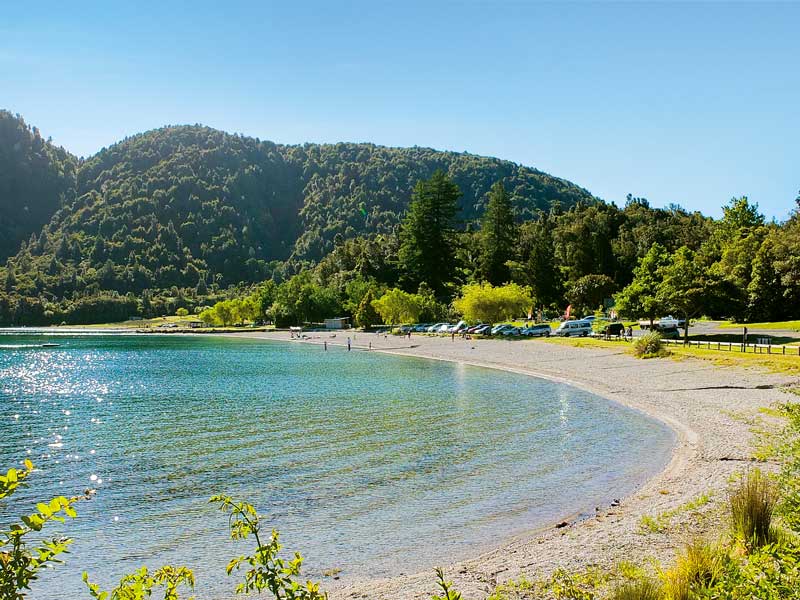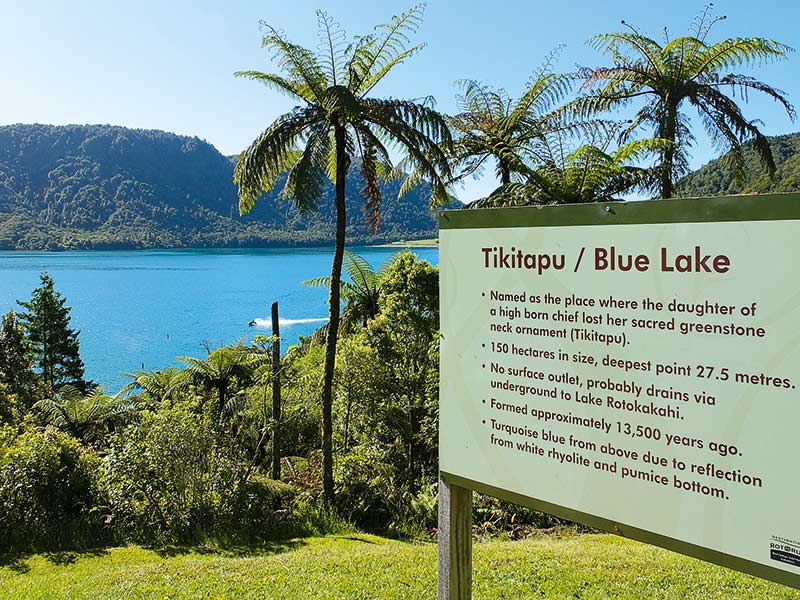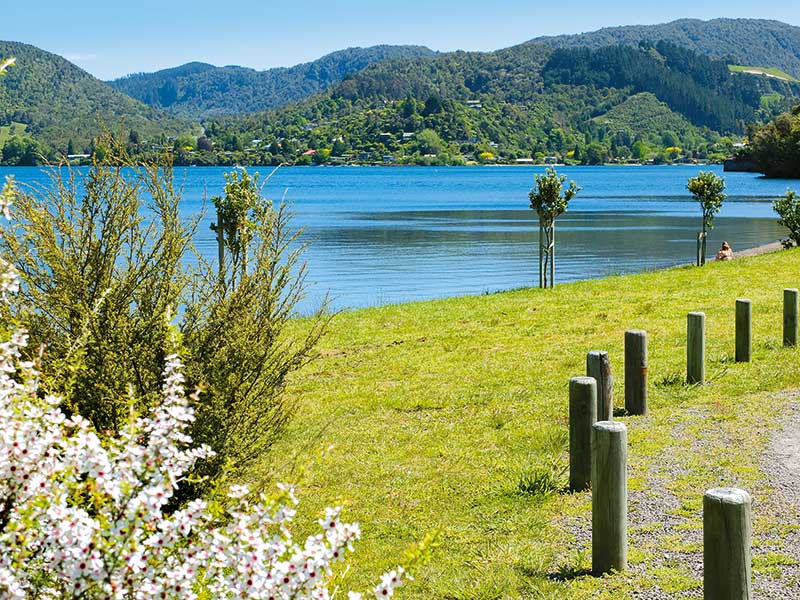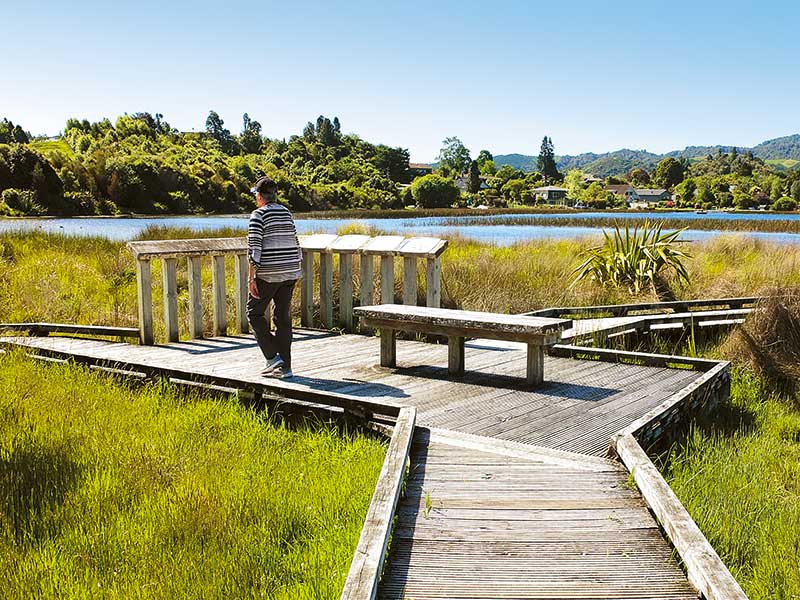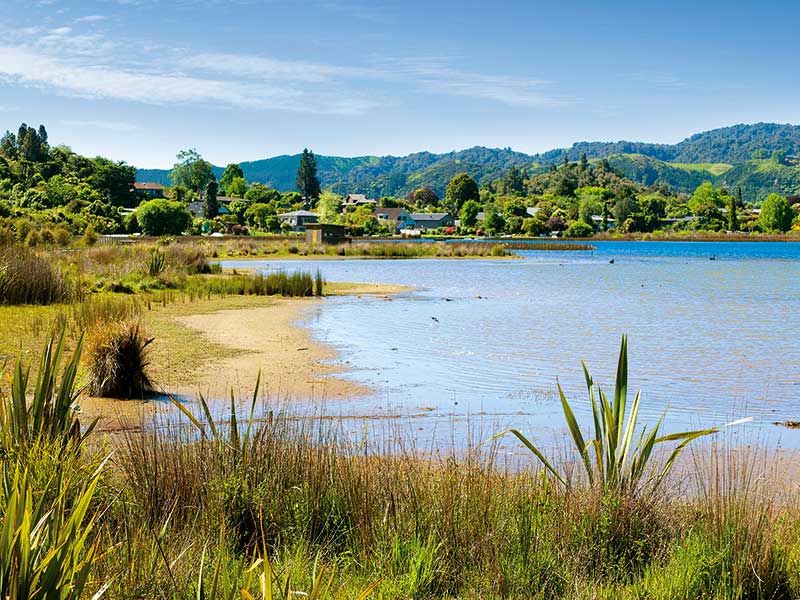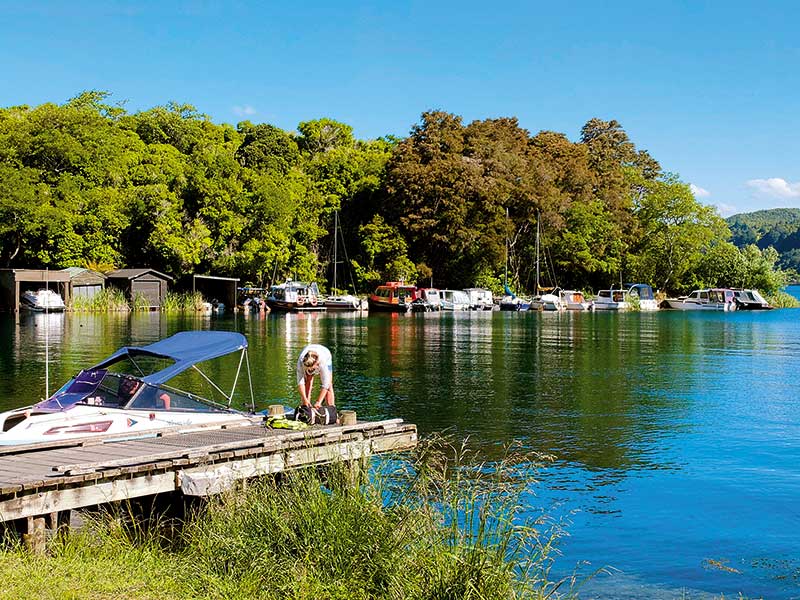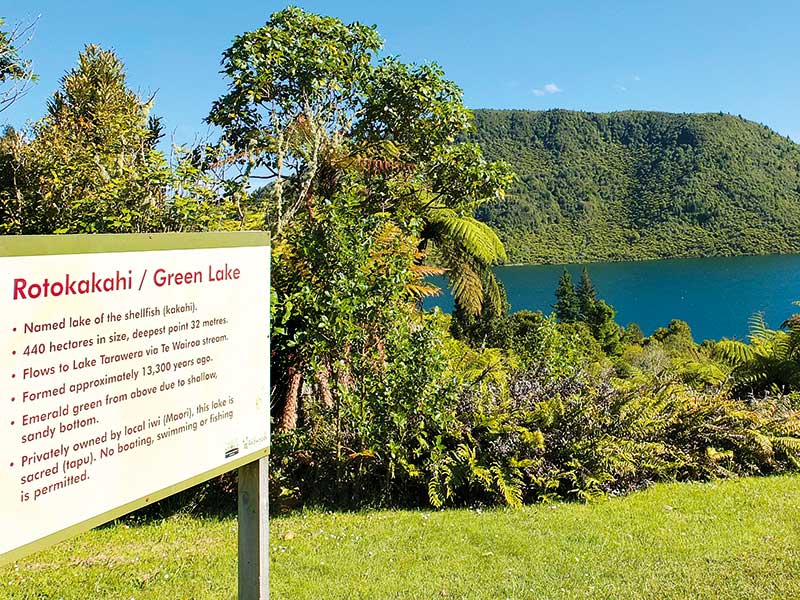Some say there are 12 lakes, not counting Rotorua. Others say there are 11. I read somewhere that there were 18, and Alex, who is a local, reckons there are 22. That’s confusing for a small brain and I decided that in the end it didn’t really matter.
Bill and I spent a few days caravan-cruising from lake to lake to uncover the go-to places for those of us who are at home on the road.
Highway 33 skirts the northern shore of Lake Rotoiti and from here it’s easy to glimpse the lake and drive on with no more comment than “oh, what a lovely view”. But there is more to Lake Rotorua’s twin than immediately meets the eye. Joined to Rotorua by the natural Ohau Channel, Rotoiti is no little sister. It is deeper than Rotorua and 17 kilometres long. The bit you see from the highway – the tranquil-looking lawns and houses gracing its edges – is only one small inlet defined by the Te Akau Peninsula.
Much of the action on Lake Rotoiti takes place around the Okere Falls on the outlet that becomes the Kaituna River and eventually tips into the Pacific Ocean at Maketu. I watched rafters and canoeists hurl themselves along the river’s gurgling rapids and, in death-defying nose-dives, hurtle down a seven-metre-high waterfall. Taking the plunge on this watery drop is only for the brave. If you feel inclined, there are several rafting/kayaking companies to choose from.
From the falls, a 30-minute walk follows the river through thick bush to end at the deep Trout Pool, which true to its name, is a popular angling spot. You can also drive there and RVs may stay overnight in the Trout Pool car park. We, however, spent the night in the delightful little Rotoiti Holiday Park on the water’s edge on Okere Road. An angler called Reg, up on his luck, gave us a trout, which we didn’t quite know what to do with.
On SH30 that skirts the southern shore of Lake Rotoiti, a turn-off points the way to Lake Okataina, which is along a very narrow road that curls through a tunnel of thick forest. I was thankful we’d left the caravan behind. There is no camping here but a day-trip is certainly worthwhile. Encircled by hills of dense kahikatea and totara forests, Okataina, where man has laid no hand on the landscape, is perhaps the loveliest lake. At the end of the road is an extensive grassy reserve with plenty of parking– unfortunately not overnight. Walking tracks cut through the bush either side of the lake, but I was more of a mind to lounge on the white pumice sand that forms a wide, seductive beach at the water’s edge.
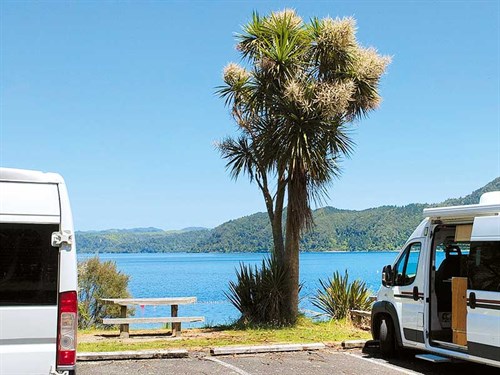
Okataina is a shortened form the Maori name ‘Lake of laughter’, so called apparently from the time that mirth from Chief Te Rangitakaroro and his merry men echoed across the water after one of them had referred to the lake as an ocean. I’m not sure I get the joke.
Drive further west on SH30, and Lake Rotoehu and Lake Rotoma soon came into view. Neither caters for RV parking overnight but there are picnic areas at Rotoma, just behind the general store, and another beside a long beach at the lake’s end on the Matahi Spit Reserve.
We back-tracked and turned into Tarawera Road, which gives access to four lakes – Blue, Green, Okareka and Tarawera.
At the Green Lake car park, a short set of steps lead to a grassy knoll from which I could compare Blue Lake (Tikitapu) to Green Lake (Rotokakahi). The difference between the two is not just in their colours (one clearly torquoisy-blue and the other khaki). Surrounded by uninterrupted native forest, Green Lake is tapu, which means no fishing, swimming or boating. There is no public access, no accommodation and it lies in its deep basin silent and undisturbed.
A sealed road leads to the wide waterfront reserve at Blue Lake. There are 200 shady sites in the adjacent Blue Lake Top Ten Holiday Park and in summer, the lake and its surroundings throb with the noise and activity from campers, swimmers, boaters, jet skiers and fishers who take to the water in droves.
Even in the cool weather of early November, people were gathered in the reserve. They were hunched over their smoking barbecues and the aroma of searing sausages was wafting through the air. You’d have to be thick-skinned to swim here (although plenty do). I put my toe in the water and I swear it began to turn blue – which is the not the way the lake got its name. The blue colour, which is not always evident, is due to its pumice and rhyolite floor.
The walkway that circles the lake begins in the reserve. To start with, it runs alongside the road and then dips and climbs through the low-lying bush that skirts the edge of the lake. It’s only about five or so kilometres-long but took this foot-dragger well over an hour to complete.
The next day the walk was much easier. Okareka, a small and less-visited lake, is set like others in an ancient volcanic caldera and until man intervened it had no surface outlet. A great walkway, 5.5km in length, skirts part of the lake’s edge to the Okareka Outlet (part of the man-made drainage system than now controls lake levels). At first the route is through recent plantings of the sort of native trees and shrubs that would have occurred here before the 1886 Mt Tarawera eruption. It continues along an astonishingly long boardwalk that winds across the swampy raupo wetlands fringing the lake. There is a well-constructed bird hide along the way. For a twitcher like me, this is waterfowl heaven.
In another part of the lake is the delightfully serene Okareka DOC camping ground, hard up against the water. It was one of the best finds in this Lake District. For the night, we parked next to a Parisian couple in a rented KEA.
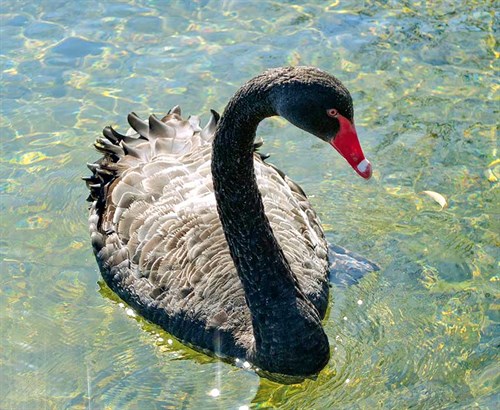
“Here is so far far away,” said Carina, sweeping her arm to take in the vista. “We cannot think of the bombs in such a beautiful place.”
I wondered if they’d heard of the Rainbow Warrior but I didn’t like to ask and spoil their peace.
The next morning we drove to Lake Tarawera. There are no camping grounds but a large reserve affords clear views of the diminished bulk of Mt Tarawera. A year ago, we took a water taxi from the wharf to the lake outlet and the start Tarawera Falls track. The trail took us through a magnificent, tree-crowded forest before dipping down to the extraordinary sight of the river dividing like tattered rags as it crashed and tumbled down a steep volcanic bluff.
It is not strictly true to say there are no camping grounds at Tarawera. The camping ground at the the Tarawera outlet is one of DOC’s most outstanding. However, you can only get to it by boat or by a forestry road from Kawerau, which requires a $5 permit. Twenty-five kilometres is on gravel, and the gates close in the evening.
The last lake we discovered was one of the smallest, but with the longest name. Lake Rerewhakaaitu is about 30 kilometres south of Rotorua off SH5. On the drive there, we passed a sign pointing to Lake Rotomahana, where much of the Eighth Wonder of the World (the Pink and White Terraces) lies buried 60 metres below the surface and the cliffs still belch with steam. The only way to see this lake is to take a boat tour.
In a flattened landscape, which like many others around here was severely clobbered by the Tarawera eruption, sprawls Lake Rerewhakaaitu – shallow reedy and home to breeding populations of scaup, banded dotterel and dabchicks. We found the small, bush-protected, slightly scruffy Brett Road DOC camp and could have spent a night or two on the Guy Roe Reserve that fits snugly into one of the lake’s toes. According to one camp resident, this lovely shady spot on the edge of a quiet reedy lagoon is serenaded at night by a thousand frogs.
Instead, we hauled into to the roomy Ash Pit Road DOC camping ground, which stretches along the shore and was so quiet I could hear the buzzing of bees and, far out on the lake, the creaking call of a black swan. The only other sound came from a soft breeze that tittered through the high branches of the cedar trees that offer shade. One of the two occupants in the camp was Tony in a Geist caravan. Of course, we had to have a mine’s-the-same-as-yours conversation. Tony comes from Rotorua and had come here on his own for a two-week break from the city.
He had comfortably nestled into his chosen spot and looked as happy as a rat with a gold front tooth. “A bit of kayaking, a bit of fishing and reading,” he said. “It’s heaven.”
I can’t be sure about that; although after a long day of driving, the serenity of Lake Rerewhakaaitu didn’t feel too far removed from paradise.
For the latest news, reviews and road trip destinations, subscribe to Motorhomes Caravans & Destinations magazine here.

